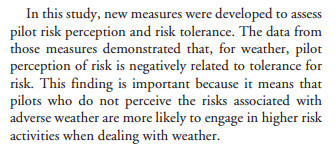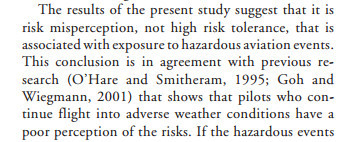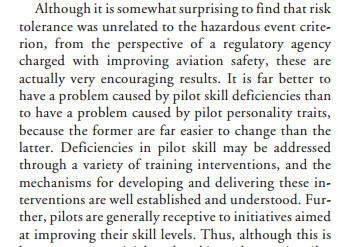Very heavy on statistics, but an interesting behavioural study. The subject comes up often, so seeing the US trying to get a more scientific handle on it was interesting.
It would take a lot of time to read and understand that study, but scanning it I was impressed by the detail of the scenarios described, and it looks like something that might be worthwhile to study more carefully. I found the conclusion interesting:
“The results suggest that it is differences in cognitive skills required for accurate risk perception that place pilots are greater likelihood of accident involvement, rather than differences in underlying personality traits related to risk tolerance”
This seems to me a rebuttal to conventional thinking. One of the reasons I like flying is the necessity to manage risk, because I like the mental challenge of doing so.
Silvaire wrote:
The results suggest that it is differences in cognitive skills required for accurate risk perception that place pilots are greater likelihood of accident involvement, rather than differences in underlying personality traits related to risk tolerance
Do I understand correctly that this means “stupid pilots are more dangerous than bold pilots”?
Basically, yes, but they can’t say that 
I wish I had the time, and a degree in Stats, to read this very good paper in detail, but some of it does resonate e.g.


which basically says that prople who don’t understand the risks tend to accept bigger risks – which is obvious.
Great conclusion:

The above contradicts the often mentioned position that “show-offs” and “posers” are more likely to get killed, which does appear to have plenty of anecdotal support (though admittedly a lot of such support is likely to be wishful thinking by people who are envious!). This study suggests that such a person is actually not higher risk – provided he/she is clever enough to understand the risks.
The problem with that assertion however is that there is likely to be a correlation between people in that category and people who don’t appreciate the risks 
Also there is likely to be a correlation between people in that category and people who don’t appreciate training. Plus a correlation between people who don’t appreciate training and people who are easily bored and seek thrills.
It’s not just flying. I have had many conversations about motorcycling (with non motorcyclists) that go along the same lines: that risk can be vastly reduced by intelligent risk management, and particularly by development of knowledge and skill, and not so much by restricted scope of activity. Convincing people of that is an uphill battle, especially when they see the occasional intelligent and skilled motorcyclist being killed or injured – some risk remains.
The above contradicts the often mentioned position that “show-offs” and “posers” are more likely to get killed, which does appear to have plenty of anecdotal support. ………………This study suggests that such a person is actually not higher risk – provided he/she is clever enough to understand the risks.
I seem to recall an interview with Bob Hoover who made exactly that point.
Peter wrote:
likely to be a correlation between people in that category and people who don’t appreciate the risks
This is an interesting study. Although some of the conclusions may sound trivial, in reality I do not think they are.
Here is the FAA Risk management handbook which is quite useful to discuss
Silvaire wrote:
It’s not just flying. I have had many conversations about motorcycling (with non motorcyclists) that go along the same lines: that risk can be vastly reduced by intelligent risk management, and particularly by development of knowledge and skill, and not so much by restricted scope of activity. Convincing people of that is an uphill battle, especially when they see the occasional intelligent and skilled motorcyclist being killed or injured – some risk remains.
The are 100s of examples like this. The problem is of course that some things just are more risky than others. You are more likely to have an accident doing high risk activity compared with a low risk activity. You cannot look at risk alone. You also have to look at what you gain by doing it, and what you lose by not doing it. Another thing is that you don’t understand the risks, unless you actually practice the risky things. When you do though, even very risky things seems like the most natural thing in the world, while when you don’t, such activity may seem completely insane.
There was a huge hysteria in the media here 4-5 years ago regarding scouts. Scouts learn to be in the woods/mountains from very young. By the age of 9-10, they go on hikes, all alone in the mountain for 1-2 nights or more. What happened was that on a national scout gathering, one patrol got lost, they didn’t arrive when supposed to, and a full SAR operation started. The weather was very bad. Media got all upset of course. 5 children lost in the mountains. All kinds of stuff, how could the leaders allow children to walk alone. How could we parents allow this (didn’t we love our children?, why didn’t they have GPS trackers? etc etc). My youngest son was there, he didn’t get lost though  Anyway, they were found within half a day. I don’t remember the details, but they did get lost in the bad weather, and got tired because they for some reason didn’t have a good night sleep the last night. They decided to go to sleep sometime in the morning. When they were found, they had just woken up, and wondered what the fuzz was all about. The point is, given the circumstance, they did the right thing. Instead of pushing on, getting back on time, which could have resulted in all kinds of accidents because they were exhausted and the poor weather. They decided to go to sleep together in their warm sleeping bags. There are almost countless stories about people who have died because they didn’t understand they needed to rest, or turn back, didn’t understand that there were no point in moving on before it was too late. After lots of fuzz in the media, it is now generally accepted that this kind of activity is a good thing (or rather, the hysterical media and over protective parents have been shut up, for now at least).
Anyway, they were found within half a day. I don’t remember the details, but they did get lost in the bad weather, and got tired because they for some reason didn’t have a good night sleep the last night. They decided to go to sleep sometime in the morning. When they were found, they had just woken up, and wondered what the fuzz was all about. The point is, given the circumstance, they did the right thing. Instead of pushing on, getting back on time, which could have resulted in all kinds of accidents because they were exhausted and the poor weather. They decided to go to sleep together in their warm sleeping bags. There are almost countless stories about people who have died because they didn’t understand they needed to rest, or turn back, didn’t understand that there were no point in moving on before it was too late. After lots of fuzz in the media, it is now generally accepted that this kind of activity is a good thing (or rather, the hysterical media and over protective parents have been shut up, for now at least).
Kindergartens usually have play apparatus for the children to climb and play on. These things are bogged down by EU regulations, and if those regulations are not followed, the parents can sue the kindergarten if an accident happens. What has happened lately is these things are being torn down, with the parents blessings. Rather, the kindergarten personnel take the children for whole days in the woods, where they can climb in trees and rocks, fall down, break arms and legs and have fun. No EU regulations exists in the woods, nothing and no one to sue, and the children learn how to stay alive.
I don’t know. Risk assessment, risk tolerance, risk acceptance, are all just nonsense words that means very little IMO. What it’s all about is survive-ability. The basics are the same weather you climb rocks or fly an aircraft. A person cannot really quantify risk in any meaningful way, it’s all statistics that is impossible to perceive and turn into action. What he can do is to make a choice between a few alternatives and relate them to his own skills, experience and comfort level. Comfort level and experience goes hand in hand, He can also minimize certain types of risk. Simple things like having an extra pad when flying, a PLB in addition to the ELT, chute or BRS and so on. But it is also a two edged sword. A higher level of survive-ability requires a broader experience and possibly better skills, and there is no way to get that without pushing your boundaries for your current comfort level. The essence of it is therefore your ability and willingness to push your boundaries. You have to be, in some sense, both bold and clever/curious. That is combined the basic “skill” of being able to survive. Hence, we let 10 year old walk alone for days in the mountain, and let kindergarten kids play around in the woods to learn to explore and push their comfort level.
Who was it here who said that the difference between aviation and motorcycling is that on two wheels your survival is to a large extent down to what other people do; in a plane it is almost always down to your own actions?
I think the flipside of over-protective parenting is that people who have never learned to assess risk properly will often do / let their children do things that are really quite risky without realising. A few years ago the Royal Society for the Prevention of Accidents argued that we need more dangerous playgrounds where there is a real chance of getting hurt – but ideally not in a life-changing way. A greenstick fracture of the wrist is a good life lesson; a spinal cord injury is overdoing things. My personal bugbear is trampolines – awful things that cause quite a lot of life-changing injuries but that look and feel safe until something goes wrong. I do let my little boy play on them, but I’d far rather have him clambering 6’ off the ground.
TBH I generally think European playgrounds do quite a good job of subtly managing risk. e.g. the first manoeuvre on a plaything is made significantly harder than all subsequent steps so that if you can climb high enough to hurt yourself, everything is likely to be well within your capability and the risks are made obvious. There’s a fairly scary (for a parent) playground locally where kids cross a chasm about 10 feet up. But it’s designed well enough that I’ve never seen or heard of anybody falling off it – and I work in the Emergency Department so I probably would. There’s a lot of regional variation in playground styles, but particularly in Belgium I’ve seen some really delightful playgrounds that leave a lot of room for imaginative play and exploration. I’m currently on holiday in Australia and the playgrounds here seem much more risk averse, not to mention industrial in character. From what I’ve seen up to now, we seem to do a much better job.
I suspect that regulation actually has some role in enabling this – when experts have set standards that are deemed to be reasonable, playground designers can probably justify more risky designs than they might otherwise go for.
For me, managing risk is one of the most satisfying things about flying. Especially as the risks are often quite abstract and you have to draw from such a broad knowledge-base to keep them within acceptable limits. I would disagree that we can’t manage them intelligently or quantify them meaningfully. When faced with undesirable alternatives, wow can we choose between them if we can’t rank them in terms of risk? If I were fatalistic about my ability to do this, I probably wouldn’t gain nearly as much satisfaction from my flying.